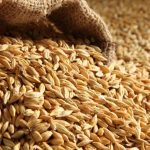 Sprouted, dried barley used in the brewing industry to help digest starches into sugars.
Sprouted, dried barley used in the brewing industry to help digest starches into sugars.
A cereal grain that has been allowed to sprout and then is dried and ground.
Partly-germinated and toasted cereal grain, in which the natural food substances present (like starches) are modified, certain vitamins enhanced, and diastatic enzymes such as amylase, which is capable of breaking down starch developed. Barley and wheat malts are used to impart taste, vitamins and digestive enzymes to food formulations, and barley malt is employed in breweries and distilleries.
A mixture of carbohydrates, predominantly maltose, produced by the breakdown of starch contained in barley or wheat grains. The cereal grain is allowed to germinate and the malt is extracted with hot water. Malt is used for brewing and distilling; it has been used as a source of nutrients in wasting diseases.
Germinated grain, usually barley, used in manufacture of ale and beer. Contains carbohydrates (dextrin, maltose), a diastase, and proteins. Used as a food, especially in wasting diseases.
Upon immersing grain into a liquid and allowing it to germinate, malt is produced for the purpose of brewing. The malt utilized in the process consists of barley which is steeped in water at a warm temperature, subjected to kiln-drying, sifted, cleaned, and mashed. Both wheat and barley are employed in the preparation of malted milk, which is ultimately dried in a vacuum.
Behold the marvelous outcome of meticulously nurturing barley into a specific stage of germination, meticulously controlled to transform its starch into dextrin and malt sugar. Once this ideal stage of germination is attained, the grains undergo a gentle heating process, rendering them into the beloved substance known as malt. Brewers of beer and ale hold malt in high regard, as it serves as a fundamental component of their craft. Additionally, the essence of malt extends its reach into various culinary realms. Enter malt extract, a rich and viscous syrup obtained by evaporating malted barley at low temperatures or within a vacuum. This dark elixir finds its way into cakes, bread, and puddings, imparting them with a distinctive flavor and delightfully moist texture. Furthermore, malt extract’s versatile nature extends to the realm of medicine, where its flavor aids in camouflaging the taste of less palatable ingredients like cod and halibut liver oils. Lastly, let us not forget the exquisite creation known as malt bread—a delectable and darkened loaf, lovingly crafted by the British using the harmonious combination of malt extract and molasses.
